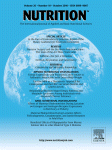Relationship between major dietary patterns and metabolic syndrome among individuals with impaired glucose tolerance
Authors
Affiliations
Abstract
Objective: Dietary habits have been associated with the prevalence of the metabolic syndrome and limited data are available in this field for individuals with impaired glucose tolerance. This study focused on the association between major dietary patterns and prevalence of the metabolic syndrome in individuals with impaired glucose tolerance.
Methods: This cross-sectional study was done in 425 subjects 35 to 55 y of age. Dietary data were collected using a food-frequency questionnaire. Blood pressure, waist circumference, glucose, triacylglycerols, and high-density lipoprotein cholesterol were measured and metabolic syndrome was defined based on Adult Treatment Panel III guidelines.
Results: Five major dietary patterns were found: a western pattern (high in sweets, butter, soda, mayonnaise, sugar, cookies, tail of a lamb, hydrogenated fat, and eggs), a prudent pattern (high in fish, peas, honey, nuts, juice, dry fruits, vegetable oil, liver and organic meat, and coconuts and low in hydrogenated fat and non-leafy vegetables), a vegetarian pattern (high in potatoes, legumes, fruits rich in vitamin C, rice, green leafy vegetables, and fruits rich in vitamin A), a high-fat dairy pattern (high in high-fat yogurt and high-fat milk and low in low-fat yogurt, peas, and bread), and a chicken and plant pattern (high in chicken, fruits rich in vitamin A, green leafy vegetables, and mayonnaise and low in beef, liver, and organic meat). After adjusting for confounding variables, the western pattern was associated with greater odds of having increased triacylglycerol (odds ratio 1.76, 95% confidence interval 1.01-3.07) and blood pressure (odds ratio 2.62, 95% confidence interval 1.32-5.23). The prudent pattern was positively associated with a prevalence of low high-density lipoprotein cholesterol levels (odds ratio 0.55, 95% confidence interval 0.31-0.96). The vegetarian dietary pattern was inversely associated with a risk of an abnormal fasting blood glucose level (odds ratio 2.26, 95% confidence interval 1.25-4.06).
Conclusion: Major dietary patterns were significantly associated with the risk of metabolic syndrome.
Keywords: Dietary patterns; Metabolic syndrome; Impaired glucose tolerance

